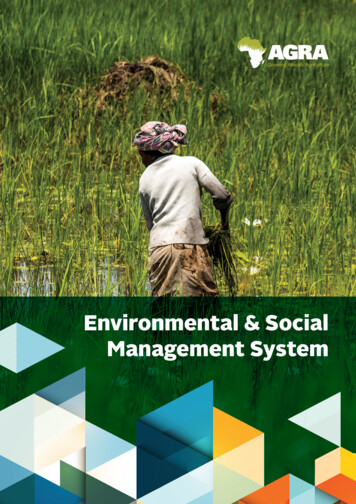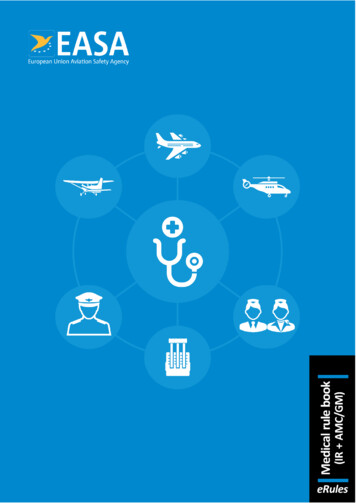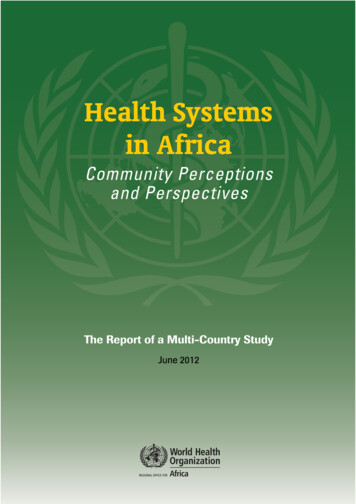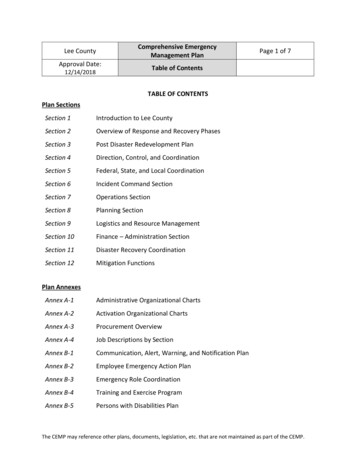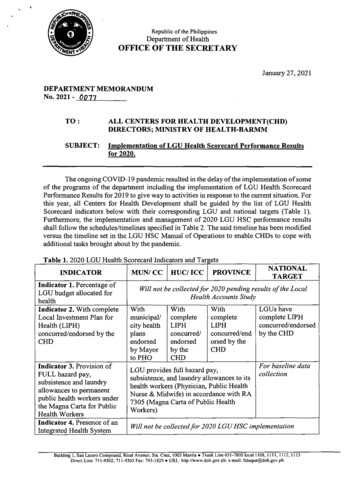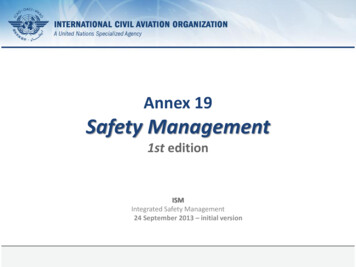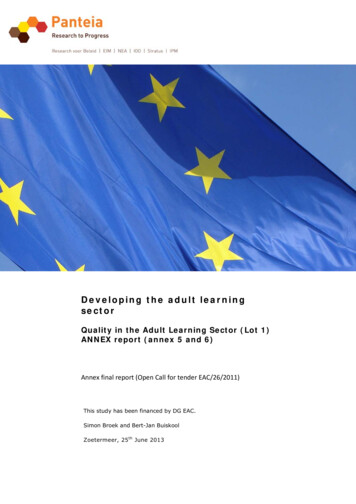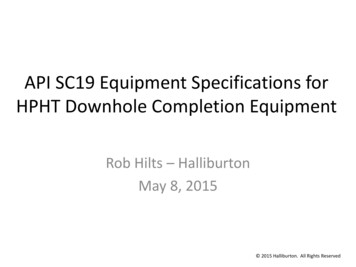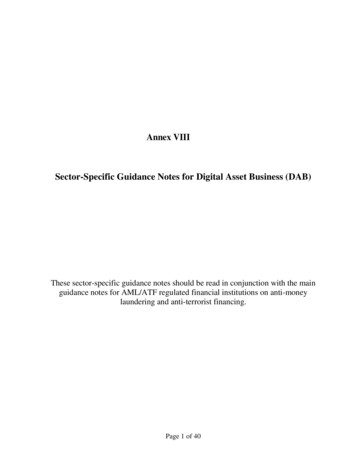
Transcription
Annex VIIISector-Specific Guidance Notes for Digital Asset Business (DAB)These sector-specific guidance notes should be read in conjunction with the mainguidance notes for AML/ATF regulated financial institutions on anti-moneylaundering and anti-terrorist financing.Page 1 of 40
ANNEX VIIISECTOR-SPECIFIC GUIDANCE NOTES FOR DIGITAL ASSET BUSINESS (DAB)ContentsIntroduction . 4Status of the guidance . 6Senior management responsibilities and internal controls. 7Links between digital asset business practices and AML/ATF policies, procedures and controls. 8Ownership, management, employee and agent checks . 9Risk-based approach for RFIs conducting digital asset business . 9ML/TF risks in the conduct of digital asset business . 11Customer due diligence. 14Purpose and intended nature of the customer’s transaction or business relationship with the RFI. 15One-off transactions, occasional transactions and business relationships . 16Linked transactions . 17Source of wealth and source of funds . 17Definition of customer in a digital asset business context . 18Definition of beneficial owner in a digital asset business context . 18Obtaining and verifying customer identification information . 19Standard identification requirements for private individuals. 19Simplified identification requirements for private individuals . 20Obtaining and verifying beneficial owner information . 21Timing of customer due diligence . 21Customer transactions involving cash or bearer instruments . 22Applicability of simplified due diligence to digital asset business . 23Refusing or terminating digital asset business . 23Enhanced due diligence for digital asset business . 24Agent networks and other third parties . 26After on-boarding the agent . 26Money or digital asset transmission and wire transfers . 27Page 2 of 40
International sanctions . 28Ongoing monitoring . 29Suspicious activity reporting. 32Failure to report and tipping-off offenses . 33Employee and agent training and awareness . 34Record-keeping . 35Digital asset businesses as customers of other RFIs . 35Risk factors for digital asset business . 36VIII.232Customer risk factors include, but are not limited to: . 36VIII.233Products and services risk factors include, but are not limited to: . 37VIII.235Delivery channel risk factors include, but are not limited to: . 38VIII.236Agent and other third party risk factors include, but are not limited to:. 38VIII.237Geographic risk factors include, but are not limited to: . 39Page 3 of 40
ANNEX VIIISECTOR-SPECIFIC GUIDANCE NOTES FOR DIGITAL ASSET BUSINESS (DAB)IntroductionVIII.1 This annex sets forth guidance on AML/ATF obligations under the Acts and Regulations of Bermudathat are specific to digital asset business (DAB). The guidelines herein are meant to supplement the2016 Guidance Notes for AML/ATF Regulated Financial institutions on AML/ATF (hereinafter, “themain guidance notes”). These guidelines are to be considered and incorporated into a DABs AMLcompliance programme requirements for purposes of implementing a robust AML complianceprogramme in accordance with the AML/ATF obligations set forth under the AML/ATF Acts andRegulations of Bermuda that are specific to DAB, also known as virtual currency business.VIII.2 Under Section 49(4)(a)(i) of the Proceeds of Crime Act and section 12A(2)(a)(i) of Anti-Terrorism(Financial and Other Measures) Act 2004 – the minister is given the power to make regulations toprescribe the classes of persons that should be subject to the regulations. Accordingly, regulation 4 ofthe Proceeds of Crime Regulations made under those provisions prescribe the persons to whom theregulations apply – hence all classes of persons in the financial services industry are togetherprescribed there as “AML/ATF regulated financial institution”. Persons carrying on DAB within themeaning of Section 2(2) of the Digital Asset Business Act 2018 are prescribed as AML/ATFregulated financial institutions (RFIs).VIII.3 With recent amendments (completed in July 2018) to the directions provisions, the term RFIs hasbeen replaced by the term “relevant person” to empower the Minister to now also be able to issuesuch directions to non-financial regulated entities. Recent amendments have also made the definitionin section 42A of POCA the sole substantive definition of the term for all of the other AML/ATFActs and Regulations.VIII.4 For the purposes of these guidance notes, the terms “AML/ATF relevant person should be understoodto include persons conducting the DAB described in paragraph VIII.5. The term “digital assetbusiness” should be understood to include any and all of the activities described in paragraph VIII.5.VIII.5 Under Section 2(2) of the Digital Asset Business Act 2018, DAB means providing any or all of thefollowing activities to the general public as a business:i. Issuing, selling or redeeming virtual coins, tokens or any other form of digital asset;This includes any business (incorporated or not) that provides these services to other businesses orindividuals. This would include an Initial Coin Offering (ICO) business on behalf of customers, butnot ICO activities to fund one’s own company or project. An example of the former that will besubject to the Digital Asset Business Act 2018 is a company that operates a facility to assist its clientsto launch ICOs. This includes assistance with coin or token design and administering the ICOprocess. An example of the latter that will not be subject to the Digital Asset Business Act 2018 is acompany that wishes to issue its own ICO for its online gaming website or other business operations.ii. Payment service provider business utilising digital assets;The term Payment Service Provider (PSP) is a term used globally and is defined in the Proceeds ofPage 4 of 40
Crime (Anti-Money Laundering and Anti-Terrorist Financing) Amendment Regulations 2010 as: “aperson whose business includes the provision of services for the transfer of funds”. The intention is tocapture businesses involved in the transfer of digital assets.iii. Operating an electronic exchange whereby digital assets of any type is, exchanged for cash oranother digital asset;Virtual currency exchanges are online exchanges that allow customers to buy and sell virtualcurrencies. Purchases and sales of digital assets can be made using either fiat currency (e.g., buyingbitcoin using GBP or USD) or digital assets (e.g., buying bitcoin using another virtual currency suchas ether). In addition to digital assets such as bitcoin and ether, digital asset exchanges may alsofacilitate the offer of new coins/tokens that are sold pursuant to ICOs/Initial Token Offerings (ITOs).iv. Provision of digital assets custodial wallet services;A digital assets wallet is a software programme that stores private and public keys and interacts withvarious blockchain to enable users to send and receive digital currency and monitor their balance. Adigital asset itself is not actually “stored” in a wallet. Instead, a private key (secure digital codeknown only to the user and the wallet) is stored as proof of ownership of a public key (a public digitalcode connected to a certain amount of currency). By the wallet storing private and public keys, itallows the user to send and receive coins, and also acts as a personal ledger of transactions. Theactivity of developing wallet software or hardware is not within the scope of these AML/ATFobligations. Rather, those that provide custodial wallet services are within scope.v. Digital assets services vendor;This category is intended to capture any business providing specific digital asset related services tothe public. This would include custodial and power of attorney rights over a customer’s virtualcurrencies or market maker in digital asset activities.VIII.6 By amending an order, the Minister may add categories of DAB in addition to those set forth inparagraph VIII.5.VIII.7 RFIs conducting DAB should read these sector-specific guidance notes in conjunction with the mainguidance notes for AML/ATF RFIs on AML/ATF. This annex supplements, but does not replace themain guidance notes.VIII.8 Under Section 10 of the Digital Asset Business Act 2018 persons conducting DAB must obtain alicence from the Bermuda Monetary Authority (the Authority) prior to commencing business inBermuda. However, section 11 of the Digital Asset Business Act 2018 provides for exemptions fromlicensure and sets forth the specific conditions where an institution carrying on DAB is not subject tothe licensing requirements described in section 10. Such an institution is nonetheless an RFI subjectto the AML/ATF requirements of Bermuda.VIII.9 All RFIs must comply with the Acts and Regulations, and with the main AML/ATF guidance notesissued by the Authority.VIII.10 Schedule 1, Section 2(2) of the Digital Asset Business Act 2018 sets forth that in determiningwhether an RFI is conducting its business in a prudent manner, the Authority will take into accountany failure to comply, among other things, with: The Digital Asset Business Act 2018; The Proceeds of Crime Act 1997;Page 5 of 40
The Anti-Terrorism (Financial and Other Measures) Act 2004; The Proceeds of Crime (Anti-Money Laundering and Anti-Terrorist Financing) Regulations 2008(Regulations); and International sanctions in effect in Bermuda.VIII.11 Portions of this annex summarise or cross-reference relevant information that is contained in detail inthe main guidance notes. The detailed information in the main guidance notes remains theauthoritative guidance.VIII.12 Portions of this annex include sector-specific information, such as risk factors that are particular toDAB. This sector-specific information should be considered as supplementary to the main guidancenotes.Status of the guidanceVIII.13 Approved by the Minister responsible for Justice, these guidance notes are issued by the Authorityunder Section 5(2) of the Proceeds of Crime (Anti-Money Laundering and Anti-Terrorist FinancingSupervision and Enforcement) Act 2008 (SEA Act 2008); and in accordance with section 49M of theProceeds of Crime Act 1997 (POCA 1997), and section 12O of the Anti-Terrorism (Financial andOther Measures) Act 2004 (ATFA 2004).VIII.14 These guidance notes are of direct relevance to all senior management, inclusive of the ComplianceOfficer, and to the Reporting Officer. The primary purpose of the notes is to provide guidance tothose who are responsible for establishing, maintaining, and overseeing the RFI’s risk-basedmanagement policies, procedures and controls for the prevention and detection of money launderingand terrorist financing (ML/TF).VIII.15 The Court, or the Authority, as the case may be, in determining whether a person is in breach of arelevant provision of the Acts or Regulations, is required to consider whether a person has followedany relevant guidance issued by the Authority and approved by the Minister responsible for Justice.These requirements upon the Court or Authority are detailed in the provisions of Section 49M ofPOCA 1997, Regulation 19(2), Section 12O of, and paragraph 1(6) of Schedule 1 to, ATFA 2004and Section 20(6) of the SEA Act 2008.VIII.16 When a provision of the Acts or Regulations is directly described in the text of this guidance, theguidance notes use the term “must” to indicate that the provision is mandatory.VIII.17 In other cases, the guidance herein uses the term “should” to indicate ways in which the requirementsof the Acts or Regulations may be satisfied, while allowing for alternative means, provided that thosealternatives effectively accomplish the same objectives.VIII.18 Departures from this guidance, and the rationale for so doing, should be documented, and RFIsshould stand prepared to justify departures to authorities such as the Bermuda Monetary Authority.VIII.19 RFIs should be aware that under Section 16 of the Financial Intelligence Agency Act 2007, theFinancial Intelligence Agency may, in the course of enquiring into a suspicious transaction or activityrelating to money laundering or terrorist financing, serve a notice in writing on any person requiringthe person to provide the Financial Intelligence Agency with such information as it may reasonablyrequire for the purpose of its enquiry. In addition, under Section 63 of the Digital Asset Business Act2018, the Authority may require a DAB under investigation for contravention of the Act, and any ofPage 6 of 40
its controllers, officers, employees, agents, bankers, auditors, barristers or attorneys, to answer theAuthority’s questions, to provide documents to the Authority and to permit the Authority’s entry intothe business’s premises.VIII.20 Detailed information is set forth in the main guidance notes, beginning with the Preface.Senior management responsibilities and internal controlsVIII.21 The AML/ATF responsibilities for senior management of an RFI conducting DAB are governedprimarily by POCA 1997, SEA Act 2008, ATFA 2004, and the POCA Regulations 2008.VIII.22 The AML/ATF internal control requirements for RFIs conducting DAB are governed primarily byRegulations 12, 16, 17A, 18 and 18A.VIII.23 Regulation 19 provides that failure to comply with the requirements of specified Regulations is acriminal offence and carries with it significant penalties. On summary conviction, the penalty is a fineof up to 50,000. Where conviction occurs on indictment, penalties include a fine of up to 750,000,imprisonment for a term of two years, or both.VIII.24 Section 20 of the SEA Act 2008 as amended in 2018 empowers the Authority to impose a penalty onan RFI of up to 10,000,000 for each failure to comply with specified Regulations. The amendmentsalso provide for a number of disciplinary measures such as the power to issue directives, the power toimpose restrictions on a licence, the power to issue a public censure, and the power to makeprohibition orders, or take other disciplinary measures as set out in Chapter 4 of Part 3 of the SEAAct amongst others.VIII.25 Under the relevant Acts and Regulations of Bermuda, senior management in all RFIs must: Ensure compliance with the Acts and Regulations; Identify, assess and effectively mitigate the ML/TF risks the RFI faces amongst its customers,products, services, transactions, delivery channels, outsourcing arrangements and geographicconnections; Conduct an AML and Sanctions risk assessment and ensure that the risk assessment findings aremaintained up to date; Appoint a Compliance Officer at the senior management level to oversee the establishment,maintenance and effectiveness of the RFI’s AML/ATF policies, procedures and controls; Appoint a Reporting Officer to process client disclosures; Screen employees against high standards; Ensure that adequate resources are periodically trained and devoted to the RFI’s AML/ATFpolicies, procedures and controls; Audit and periodically test the RFI’s AML/ATF policies, procedures and controls foreffectiveness and address any issues uncovered adequately and timely; and Recognise potential personal liability if legal obligations are not met.Page 7 of 40
VIII.26 RFIs must establish and maintain detailed risk-based policies, procedures and controls that areadequate and appropriate to forestall and prevent operations related to ML/TF. The risk-basedapproach measures are detailed in paragraph VIII.40 belowVIII.27 Under Section 12(6) (c) of the Digital Asset Business Act 2018, an RFI must include its AML/ATFpolicies and procedures with its application for a DAB licence.VIII.28 Under Schedule 1, paragraph 5 (Consolidated supervision) of the Digital Asset Business Act 2018, aDAB must ensure that the structure of any group to which it belongs does not obstruct the conduct ofeffective consolidated supervision.VIII.29 Where a Bermuda RFI conducting DAB has agents, branches, subsidiaries or representative officeslocated in a country or territory other than Bermuda, it must communicate its AML/ATF policies andprocedures to all such entities, and must ensure that all such entities apply AML/ATF measures atleast equivalent to those set out in the AML/ATF Bermuda Acts and Regulations.VIII.30 Attempts to launder money through DAB may be carried out in several ways: Externally, by a customer seeking to place, layer or integrate illicit assets; Internally, by a director, manager or employee, either individually or in collusion with othersinside and/or outside the RFI conducting illicit DAB; and Indirectly, by a third party service provider or by an RFI, independent professional, agent orother intermediary facilitating transactions involving illicit assets on behalf of another person.VIII.31 The majority of this annex addresses attempted money laundering by customers. Money launderingrisks involving internal senior management, directors, managers, employees and agents are addressedvia the screening for fit and proper requirements for DAB in paragraphs VIII.36 through VIII.39.Money laundering risks involving agents and other third parties are addressed in paragraphs VIII.159through VIII.168.VIII.32 Specific requirements for an RFI’s detailed policies, procedures and controls are set forth in Chapters2 through 11 of the main guidance notes.VIII.33 Detailed information is set forth in Chapter 1: Senior Management Responsibilities and InternalControls of the main guidance notes.Links between digital asset business practices and AML/ATF policies, procedures andcontrolsVIII.34 An RFI’s compliance with the Digital Asset Business Act 2018 achieves some of Bermuda’sAML/ATF objectives. These objectives are also met in part through an RFI’s compliance with therequirements, principles, standards and procedures set forth in guidance documents, including, but notlimited to: Code of Practice - Digital Asset Business Act 2018 Statement of Principles - Digital Asset Business Act 2018VIII.35 The requirements of the AML/ATF Acts, Regulations and any additional guidance documentsdescribed in paragraph VIII.33 provide a suitable foundation for the AML/ATF policies, proceduresand controls that Bermuda RFIs are required to adopt and implement. An RFI should not presume,Page 8 of 40
however, that its existing processes are sufficient. Each RFI must ensure that it meets each of itsAML/ATF obligations under the AML/ATF Bermuda Acts, Regulations and these guidance notes,whether as part of its existing business processes or through separate processes.Ownership, management, employee and agent checksVIII.36 To guard against potential money laundering involving owners, directors, managers, employees andagents of DABs, RFIs conducting money business should screen such persons against high standardsin accordance with paragraphs 1.70 through 1.74 of the main guidance notes.VIII.37 RFIs should ensure that screenings are conducted both for the RFI itself and for any agent,intermediary or third party service provider.VIII.38 Where any screening is conducted by a third party, the RFI should have procedures to satisfy itself asto the effectiveness of the screening procedures the third party uses to ensure the competence andprobity of each person subject to screening.VIII.39 Working with agents, intermediaries and third party service providers that are licenced and that applyAML/ATF measures at least equivalent to those in Bermuda is likely to reduce the measures aBermuda RFI conducting DAB will need to undertake in order to meet its screening obligations.Risk-based approach for RFIs conducting digital asset businessVIII.40 RFIs conducting DAB must employ a risk-based approach in determining: Appropriate levels of customer due diligence (CDD) measures for different customer types; Proportionate risk-mitigation measures to prevent the abuse of the RFI’s products, services,customer information, and delivery channels for ML/TF purposes; The scope and frequency of ongoing monitoring of a business relationship with a customer, andof transactions for which the RFI conducts CDD and screening against requisite sanctions/TFlists; The scope and frequency of conducting on-going/periodic reviews of customer files based ontheir assigned risk rating or score, and customer type; and Measures for monitoring, detecting and reporting suspicious activity to the appropriateauthorities; as well as monitoring for activity that may increase a customer’s risk profile.VIII.41 The purpose of an RFI applying a risk-based approach is to balance the cost of AML/ATFcompliance resources with a realistic assessment of the risk of the RFI being used in connection withML/TF. A risk-based approach focuses resources and efforts where they are needed, and where theyhave the greatest impact in preventing and suppressing ML/TF.VIII.42 By adopting a risk-based approach, competent authorities and financial institutions are able to ensurethat measures to prevent or mitigate money laundering and terrorist financing are commensurate withthe risks identified;Page 9 of 40
VIII.43 Adopting a risk-based approach implies the adoption of a risk management process for dealing withmoney laundering and terrorist financing. This process encompasses recognising the existence of therisk(s) and developing strategies to manage and mitigate the identified risks.VIII.44 The higher the risk an RFI faces from any particular combination of agent, customer, product, service,transaction, delivery channel or geographic connection, the stronger and/or more numerous the RFI’smitigation measures must be.VIII.45 Each RFI should ensure that it has sufficient capacity and expertise to manage the risks it faces. Asrisks and understandings of risk evolve, an RFI’s capacity and expertise should also evolveproportionally.VIII.46 An RFI’s assessment of the ML/TF risks associated with a customer or transaction should beconducted independently, and in a manner that demonstrates high standards of professionalismextending beyond simply fulfilling the requirements of the Acts and Regulations.VIII.47 RFIs must use a risk-based approach to determine whether each customer or business relationshipentails a heightened level of ML/TF risk.VIII.48 Although RFIs conducting DAB should target compliance resources toward higher-risk situations,they must also continue to apply risk mitigation measures to any standard- and lower-risk situations,commensurate with the risks identified. The fact that a customer or transaction is assessed as beinglower risk does not mean the customer or transaction is not involved in ML/TF.VIII.49 RFIs should document and be in a position to justify the basis on which they have assessed the levelof risk associated with each particular combination of customer, product, service, transaction,delivery channel or geographic connection. This can be achieved by performing an assessment of aDABs AML and sanctions/terrorist financing risks, by way of conducting AML and sanctions riskassessments periodically. To do this effectively, a risk assessment methodology should be established.VIII.50 When designing a new product or service or when venturing into the use of new technology platformsfor delivery of new or existing products or services, an RFI conducting DAB must assess the risk ofthe product or service being used for ML/TF.VIII.51 Managing the money laundering and terrorist financing risks arising from DAB is an ongoingprocess, not a one-off exercise.VIII.52 RFIs must document the risk assessment procedures and controls, such as internal compliance audits,as this helps to keep them under regular review. There should be a process for monitoring whethersuch systems are working effectively, and how to improve them; for example, to reflect changes inthe business environment, such as new product types or business models.VIII.53 Detailed information on the requirement that RFIs use a risk-based approach to mitigate the risks ofbeing used in connection with ML/TF is set forth in Chapter 2: Risk-Based Approach of the mainguidance.VIII.54 Managing the cybercrime activity that DABs are susceptible to is important and requires the DAB toassess the cyber risks it faces by establishing appropriate controls to reduce these risks. DABs shouldcomply with the cybersecurity rules set forth in the Authority’s Digital Asset Business(Cybersecurity) Rules 2018 and the Digital Asset Business Code of Practice.Page 10 of 40
ML/TF risks in the conduct of digital asset businessVIII.55 Using the risk-based approach, each RFI conducting DAB should determine the amount of ML/TFrisk it will accept in pursuit of its business goals.VIII.56 Nothing in the Acts or Regulations prevents an RFI from deliberately choosing to accept higher-riskbusiness. Each RFI must, however, ensure that it has the capacity and expertise to apply riskmitigation measures that are commensurate with the risks it faces, and that it does effectively applythose measures.VIII.57 The DAB sector is often considered as posing a high risk of ML/TF. Criminals may be attracted to thesector because DAB: transactions are often fast, simple and irreversible; often involve cash or other digital asset products that do not necessarily rely upon other RFIs; is largely unregulated in many jurisdictions; may be cross-border, with a global reach; transactions in the case of certain DAB types are often one-off transactions, taking place outsideof an established business relationship that could be otherwise more readily monitored foruncharacteristic behaviour; products and techniques could be used to facilitate anonymity, or to exploit a false identity; and activity involving agents, risks the agents not properly following appropriate AML/ATFpolicies, procedures and controls.VIII.58 Although some DABs or digital assets may be abused by criminals for ML/TF purposes, not allDABs or digital assets are inherently high-risk for ML/TF.VIII.59 The level of inherent risk associated with a particular DAB depends upon a number of factors,including, but not limited to: The size of the DAB; The products and services the business offers; The volume of activity being conducted through the business (domestically and/or globally); The extent to which branches and agents are involved in the business; The complexity of any payment chains used; The geographic areas in which the business operates; and The identity and geographic origin of the business’s customers.VIII.60 The level of inherent ML/TF risk may be lower where the business: Primarily markets to customers conducting, what the DAB has determined to be, routinetransactions (relative to the customers’ nature of business) with moderate frequency in low orexpected amounts;Page 11 of 40
Is a digital asset transmitter that only remits virtual funds to domestic entities, particularlywhere both customer and recipients are RFIs and subject to AML/ATF regulations; Offers only a
VIII.1 This annex sets forth guidance on AML/ATF obligations under the Acts and Regulations of Bermuda that are specific to digital asset business (DAB). The guidelines herein are meant to supplement the 2016 Guidance Notes for AML/ATF Regulated Financial institutions on AML/ATF (hereinafter, "the main guidance notes").
